现在分词作状语详解
- 格式:ppt
- 大小:416.00 KB
- 文档页数:35

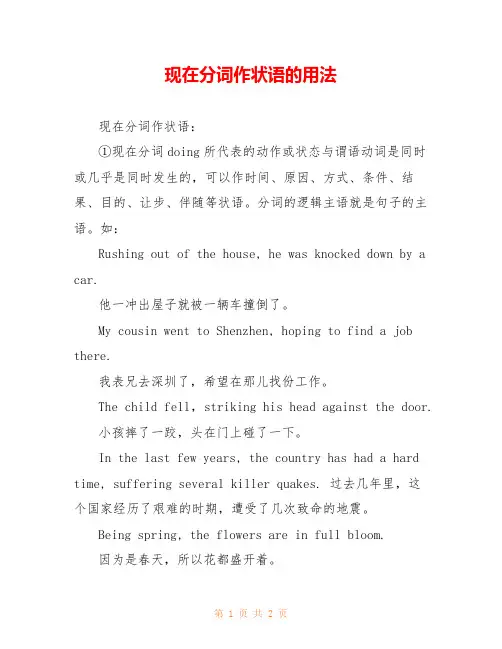
现在分词作状语的用法现在分词作状语:①现在分词doing所代表的动作或状态与谓语动词是同时或几乎是同时发生的,可以作时间、原因、方式、条件、结果、目的、让步、伴随等状语。
分词的逻辑主语就是句子的主语。
如:Rushing out of the house, he was knocked down by a car.他一冲出屋子就被一辆车撞倒了。
My cousin went to Shenzhen, hoping to find a jobthere.我表兄去深圳了,希望在那儿找份工作。
The child fell,striking his head against the door.小孩摔了一跤,头在门上碰了一下。
In the last few years, the country has had a hard time, suffering several killer quakes. 过去几年里,这个国家经历了艰难的时期,遭受了几次致命的地震。
Being spring, the flowers are in full bloom.因为是春天,所以花都盛开着。
②有些分词作状语,没有逻辑上的主语,已成为习惯用法:considering, judging from, talking of, allowingfor(考虑到),generally/frankly/honestly/roughly/strictly speaking, assuming that(假设)等。
如:Talking of this film, its wonderful.说到这部电影,好极了。
Assuming that it is true, what should we do now 假定那是真的, 我们现在该怎麽办Judging by the direction of the wind, it wont rain today.根据风向测度, 今天不会下雨。
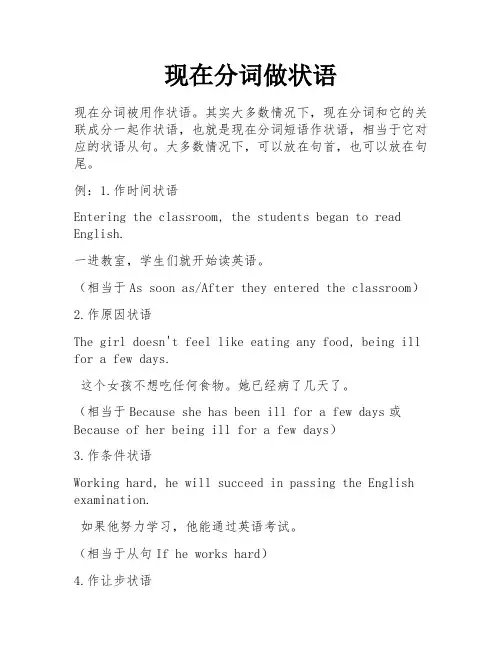
现在分词做状语现在分词被用作状语。
其实大多数情况下,现在分词和它的关联成分一起作状语,也就是现在分词短语作状语,相当于它对应的状语从句。
大多数情况下,可以放在句首,也可以放在句尾。
例:1.作时间状语Entering the classroom, the students began to read English.一进教室,学生们就开始读英语。
(相当于As soon as/After they entered the classroom)2.作原因状语The girl doesn't feel like eating any food, being ill for a few days.这个女孩不想吃任何食物。
她已经病了几天了。
(相当于Because she has been ill for a few days或Because of her being ill for a few days)3.作条件状语Working hard, he will succeed in passing the English examination.如果他努力学习,他能通过英语考试。
(相当于从句If he works hard)4.作让步状语Being tired after work, he still insists on studying French.下班后很累,他仍然坚持学习法语。
(相当于Though he is tired after work或Though tired after work)5.作结果状语People all over the world sing the song, making it popular.全世界的人都唱这首歌,这使它流行起来。
(相当于so that they make it popular)6.作方式状语Travelling by car , we enjoyed many beautifull places.开车旅行时,我们欣赏了许多美丽的地方。
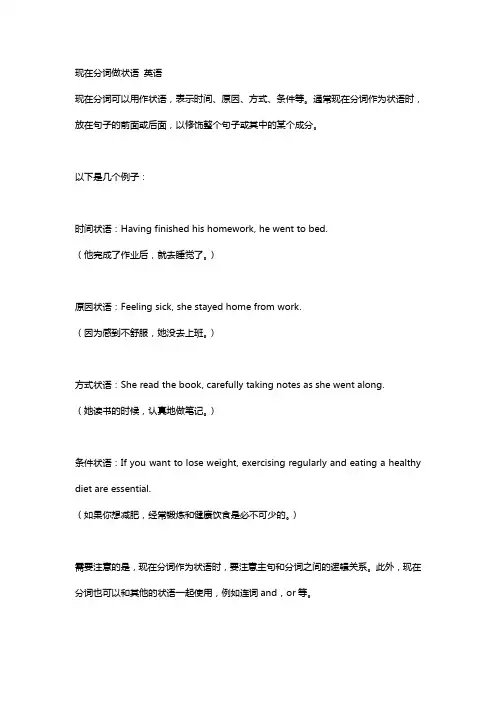
现在分词做状语英语
现在分词可以用作状语,表示时间、原因、方式、条件等。
通常现在分词作为状语时,放在句子的前面或后面,以修饰整个句子或其中的某个成分。
以下是几个例子:
时间状语:Having finished his homework, he went to bed.
(他完成了作业后,就去睡觉了。
)
原因状语:Feeling sick, she stayed home from work.
(因为感到不舒服,她没去上班。
)
方式状语:She read the book, carefully taking notes as she went along.
(她读书的时候,认真地做笔记。
)
条件状语:If you want to lose weight, exercising regularly and eating a healthy diet are essential.
(如果你想减肥,经常锻炼和健康饮食是必不可少的。
)
需要注意的是,现在分词作为状语时,要注意主句和分词之间的逻辑关系。
此外,现在分词也可以和其他的状语一起使用,例如连词and,or等。
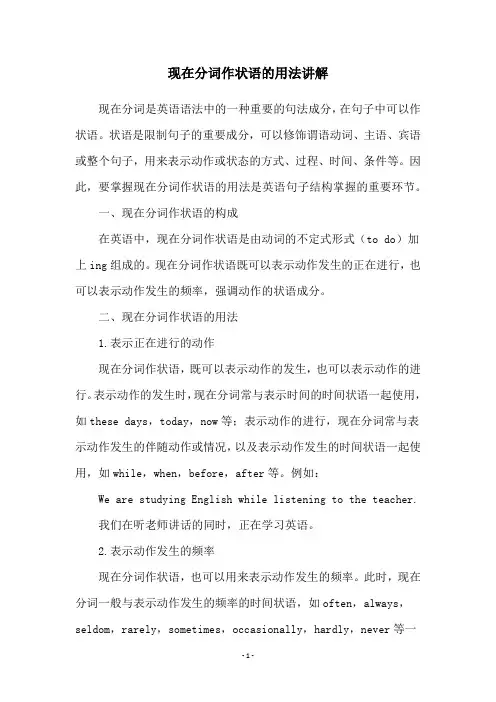
现在分词作状语的用法讲解现在分词是英语语法中的一种重要的句法成分,在句子中可以作状语。
状语是限制句子的重要成分,可以修饰谓语动词、主语、宾语或整个句子,用来表示动作或状态的方式、过程、时间、条件等。
因此,要掌握现在分词作状语的用法是英语句子结构掌握的重要环节。
一、现在分词作状语的构成在英语中,现在分词作状语是由动词的不定式形式(to do)加上ing组成的。
现在分词作状语既可以表示动作发生的正在进行,也可以表示动作发生的频率,强调动作的状语成分。
二、现在分词作状语的用法1.表示正在进行的动作现在分词作状语,既可以表示动作的发生,也可以表示动作的进行。
表示动作的发生时,现在分词常与表示时间的时间状语一起使用,如these days,today,now等;表示动作的进行,现在分词常与表示动作发生的伴随动作或情况,以及表示动作发生的时间状语一起使用,如while,when,before,after等。
例如:We are studying English while listening to the teacher.我们在听老师讲话的同时,正在学习英语。
2.表示动作发生的频率现在分词作状语,也可以用来表示动作发生的频率。
此时,现在分词一般与表示动作发生的频率的时间状语,如often,always,seldom,rarely,sometimes,occasionally,hardly,never等一起使用。
例如:He is always playing computer games.他总是玩电脑游戏。
三、现在分词作状语的特殊情况1.在分词作独立主格结构在句子中,现在分词与主语之间也可以组成独立结构,即现在分词作独立主格结构,表示一种客观存在的状态。
此时,现在分词作独立主格结构,可以表示谓语动词所描述的动作发生的情况,也可以表示谓语动词的客观存在的状态。
Seeing is believing.百闻不如一见。
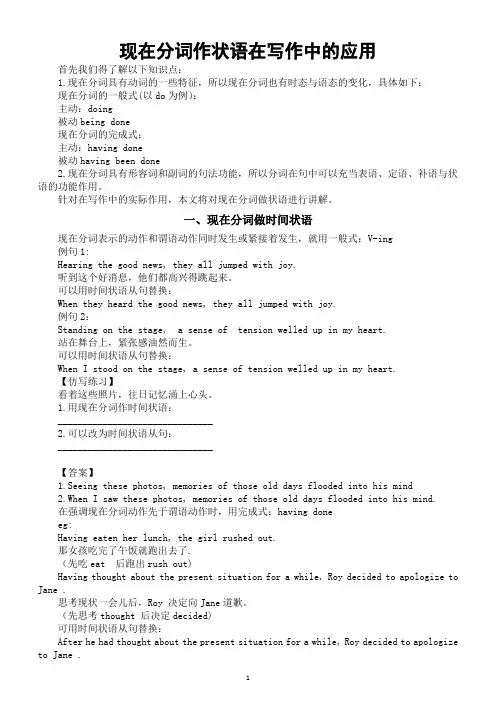
现在分词作状语在写作中的应用首先我们得了解以下知识点:1.现在分词具有动词的一些特征,所以现在分词也有时态与语态的变化,具体如下:现在分词的一般式(以do为例):主动:doing被动being done现在分词的完成式:主动:having done被动having been done2.现在分词具有形容词和副词的句法功能,所以分词在句中可以充当表语、定语、补语与状语的功能作用。
针对在写作中的实际作用,本文将对现在分词做状语进行讲解。
一、现在分词做时间状语现在分词表示的动作和谓语动作同时发生或紧接着发生,就用一般式:V-ing例句1:Hearing the good news, they all jumped with joy.听到这个好消息,他们都高兴得跳起来。
可以用时间状语从句替换:When they heard the good news, they all jumped with joy.例句2:Standing on the stage, a sense of tension welled up in my heart.站在舞台上,紧张感油然而生。
可以用时间状语从句替换:When I stood on the stage, a sense of tension welled up in my heart.【仿写练习】看着这些照片,往日记忆涌上心头。
1.用现在分词作时间状语:_______________________________2.可以改为时间状语从句:_______________________________【答案】1.Seeing these photos, memories of those old days flooded into his mind2.When I saw these photos, memories of those old days flooded into his mind.在强调现在分词动作先于谓语动作时,用完成式:having doneeg:Having eaten her lunch, the girl rushed out.那女孩吃完了午饭就跑出去了.(先吃eat 后跑出rush out)Having thought about the present situation for a while, Roy decided to apologize to Jane .思考现状一会儿后,Roy 决定向Jane道歉。
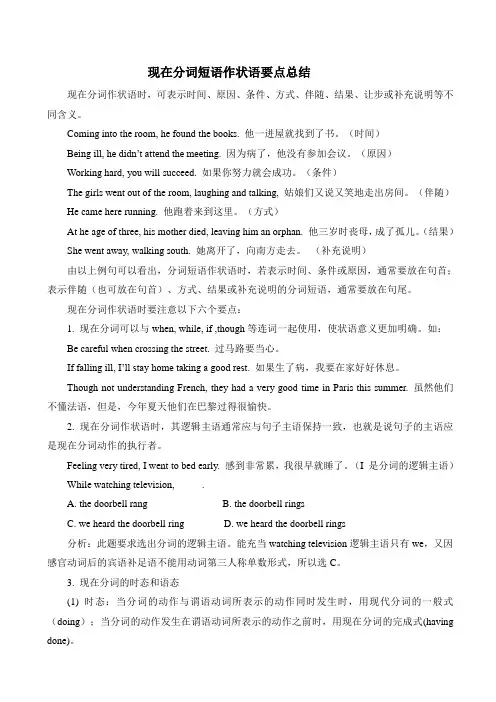
现在分词短语作状语要点总结现在分词作状语时,可表示时间、原因、条件、方式、伴随、结果、让步或补充说明等不同含义。
Coming into the room, he found the books. 他一进屋就找到了书。
(时间)Being ill, he didn’t attend the meeting. 因为病了,他没有参加会议。
(原因)Working hard, you will succeed. 如果你努力就会成功。
(条件)The girls went out of the room, laughing and talking, 姑娘们又说又笑地走出房间。
(伴随)He came here running. 他跑着来到这里。
(方式)At he age of three, his mother died, leaving him an orphan. 他三岁时丧母,成了孤儿。
(结果)She went away, walking south. 她离开了,向南方走去。
(补充说明)由以上例句可以看出,分词短语作状语时,若表示时间、条件或原因,通常要放在句首;表示伴随(也可放在句首)、方式、结果或补充说明的分词短语,通常要放在句尾。
现在分词作状语时要注意以下六个要点:1. 现在分词可以与when, while, if ,though等连词一起使用,使状语意义更加明确。
如:Be careful when crossing the street. 过马路要当心。
If falling ill, I’ll stay home taking a good rest. 如果生了病,我要在家好好休息。
Though not understanding French, they had a very good time in Paris this summer. 虽然他们不懂法语,但是,今年夏天他们在巴黎过得很愉快。
2. 现在分词作状语时,其逻辑主语通常应与句子主语保持一致,也就是说句子的主语应是现在分词动作的执行者。
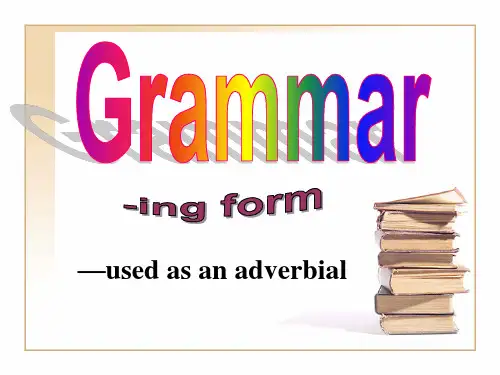
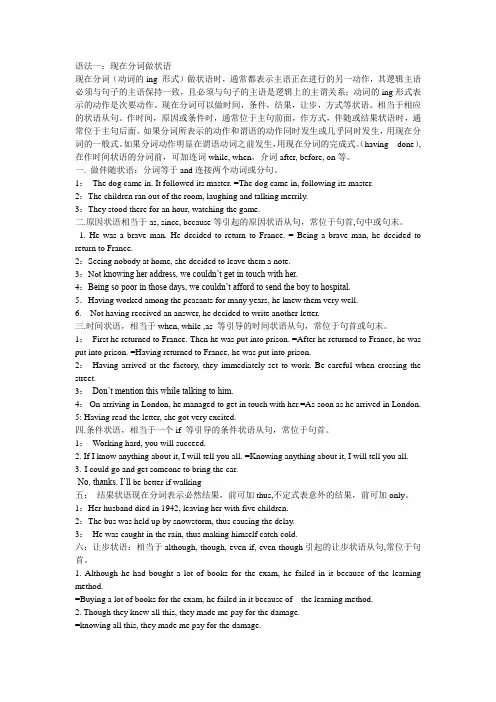
语法一:现在分词做状语现在分词(动词的ing 形式)做状语时,通常都表示主语正在进行的另一动作,其逻辑主语必须与句子的主语保持一致,且必须与句子的主语是逻辑上的主谓关系;动词的ing形式表示的动作是次要动作。
现在分词可以做时间,条件,结果,让步,方式等状语。
相当于相应的状语从句。
作时间,原因或条件时,通常位于主句前面,作方式,伴随或结果状语时,通常位于主句后面。
如果分词所表示的动作和谓语的动作同时发生或几乎同时发生,用现在分词的一般式。
如果分词动作明显在谓语动词之前发生,用现在分词的完成式。
(having done),在作时间状语的分词前,可加连词while, when,介词after, before, on等。
一. 做伴随状语:分词等于and连接两个动词或分句。
1:The dog came in. It followed its master. =The dog came in, following its master.2:The children ran out of the room, laughing and talking merrily.3:They stood there for an hour, watching the game.二.原因状语相当于as, since, because等引起的原因状语从句,常位于句首,句中或句末。
1. He was a brave man. He decided to return to France. = Being a brave man, he decided to return to France.2:Seeing nobody at home, she decided to leave them a note.3:No t knowing her address, we couldn‟t get in touch with her.4:Being so poor in those days, we couldn‟t afford to send the boy to hospital.5.Having worked among the peasants for many years, he knew them very well.6. Not having received an answer, he decided to write another letter.三.时间状语,相当于when, while ,as 等引导的时间状语从句,常位于句首或句末。
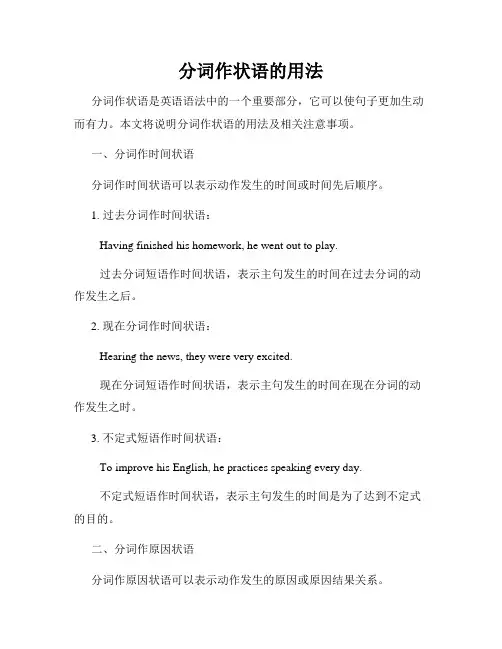
分词作状语的用法分词作状语是英语语法中的一个重要部分,它可以使句子更加生动而有力。
本文将说明分词作状语的用法及相关注意事项。
一、分词作时间状语分词作时间状语可以表示动作发生的时间或时间先后顺序。
1. 过去分词作时间状语:Having finished his homework, he went out to play.过去分词短语作时间状语,表示主句发生的时间在过去分词的动作发生之后。
2. 现在分词作时间状语:Hearing the news, they were very excited.现在分词短语作时间状语,表示主句发生的时间在现在分词的动作发生之时。
3. 不定式短语作时间状语:To improve his English, he practices speaking every day.不定式短语作时间状语,表示主句发生的时间是为了达到不定式的目的。
二、分词作原因状语分词作原因状语可以表示动作发生的原因或原因结果关系。
1. 过去分词作原因状语:Being tired, she decided to go to bed early.过去分词短语作原因状语,表示主句发生的原因是过去分词的动作。
2. 现在分词作原因状语:Seeing the dark clouds, they decided to bring umbrellas.现在分词短语作原因状语,表示主句发生的原因是现在分词的动作。
3. 不定式短语作原因状语:To save money, he stopped eating out.不定式短语作原因状语,表示主句发生的原因是不定式的目的。
三、分词作条件状语分词作条件状语可以表示动作发生的条件或条件结果关系。
1. 过去分词作条件状语:Given the chance, he would travel around the world.过去分词短语作条件状语,表示主句发生的条件是过去分词的动作。
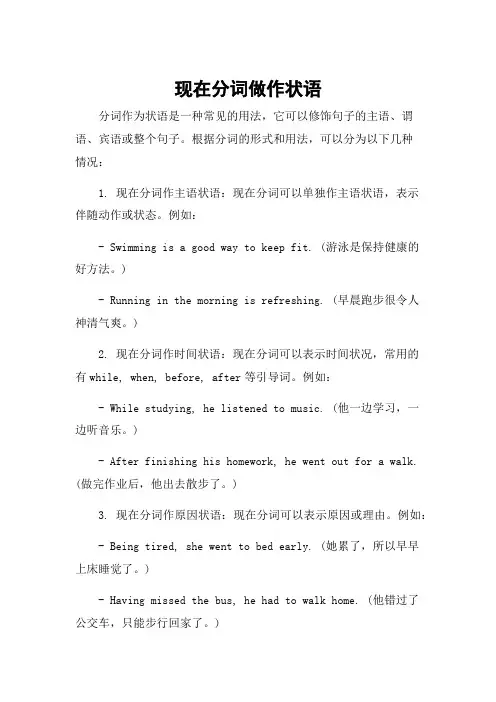
现在分词做作状语分词作为状语是一种常见的用法,它可以修饰句子的主语、谓语、宾语或整个句子。
根据分词的形式和用法,可以分为以下几种情况:1. 现在分词作主语状语:现在分词可以单独作主语状语,表示伴随动作或状态。
例如:- Swimming is a good way to keep fit. (游泳是保持健康的好方法。
)- Running in the morning is refreshing. (早晨跑步很令人神清气爽。
)2. 现在分词作时间状语:现在分词可以表示时间状况,常用的有while, when, before, after等引导词。
例如:- While studying, he listened to music. (他一边学习,一边听音乐。
)- After finishing his homework, he went out for a walk. (做完作业后,他出去散步了。
)3. 现在分词作原因状语:现在分词可以表示原因或理由。
例如:- Being tired, she went to bed early. (她累了,所以早早上床睡觉了。
)- Having missed the bus, he had to walk home. (他错过了公交车,只能步行回家了。
)4. 现在分词作结果状语:现在分词可以表示结果,常用的情况有so, therefore等引导词。
例如:- He studied hard so as to pass the exam. (他努力学习,以便通过考试。
)- The weather was bad, so they stayed at home. (天气不好,所以他们呆在家里。
)。
现在分词做结果状语
现在分词作为结果状语,通常用来说明某个动作或状态所带来的结果
或影响。
这种分词可以单独使用,也可以和其他成分一起构成复合结构。
1. 单独使用
现在分词作为结果状语时,常常用来表示主句中的动作或状态所带来
的后果或影响。
例如:
- 他走得匆忙,一路上碰到了不少人。
- 她说话声音很大,把整个教室都吵醒了。
- 我看到他穿着一身黑色西装,显得非常帅气。
2. 与其他成分构成复合结构
现在分词也可以和其他成分一起构成复合结构,进一步强调主句中的
动作或状态所带来的结果或影响。
以下是几种常见的复合结构:
- 现在分词+ 宾语:表示主句中的动作或状态对宾语产生了什么影响。
例如:
- 我看到她笑着走过来了。
- 她听到这个消息后,很失望。
- 现在分词 + 时间状语:表示主句中的动作或状态发生的同时,另外一个动作或状态也在进行。
例如:
- 他边听音乐边做作业。
- 她一边吃饭一边看电视。
- 现在分词 + 原因状语:表示主句中的动作或状态的原因。
例如:
- 他心情不好,所以一直在发牢骚。
- 她太累了,所以睡不着觉。
总之,现在分词作为结果状语可以帮助我们更加准确地描述某个动作或状态所带来的结果或影响,使语言更加生动、形象。
现在分词在句子中作状语的用法介绍现在分词在句子中作状语的用法介绍你知道现在分词在句子中的用法吗?下面是小编收集的现在分词在句子中作状语的用法介绍。
欢迎阅读!一、分词在句子中作状语,可以表示时间、条件、原因、结果、让步、伴随等。
分词(短语)作状语时,其逻辑主语应与句中主语相一致。
当现在分词表示的动作发生在谓语动词之前时, 则用现在分词的完成式;当所表示的`动作与谓语的动作同时发生, 则用现在分词的一般式。
完成或被动关系用过去分词。
二、现在分词作状语时,其逻辑主语应该与句子的主语一致,但有时现在分词的主语与其所在句中的主语并不一致,这种现在分词即所谓的垂悬现在分词。
垂悬现在分词容易使句意模糊,甚至造成歧义,因而通常被认为是不合规范或错误的用法。
1.Searching along the deck,it had taken him some time to find a doctor.他沿着甲板找了好久才找到一名医生。
(searching的逻辑主语是句中的him)2.Walking or sleeping,this subject was always in my mind.不论是走路或睡觉,我总是在想着这个问题。
(walking or sleeping的逻辑主语是句中的my)3.Traveling is interesting but tiring.旅行是有趣的,但是使人疲劳4.The pupils will get confused if they are made to learn too much.如果让学生学得太多,他们会感到糊涂的。
5.The argument is very convincing.他的论点很令人信服。
6.They were very excited at the news.听到这个消息,他们非常激动。
三、现在分词或过去分词作状语时,有时可以在分词前加while,when, once, although, until, if等连词。
用作状语的分词称为分词从句或分词短语,用于表示句子中与主动词同时发生或在主动词之后发生的动作。
以下是将分词用作状语的一些常见方法:
分词短语:分词短语是分词加上任何宾语、补语和/或修饰语。
例如,“在公园散步时,她看到了一只兔子”。
在这句话中,“walking in the park”是分词短语,作为状语修饰“she saw”。
现在分词:现在分词是由动词的基本形式加上“-ing”构成的。
例如,“工作到很晚,她半夜才回家”。
在这句话中,“Working late”是现在分词,作为状语修饰“she didn't get home until midnight”。
过去分词:过去分词通常通过在规则动词后加“-ed”或对不规则动词使用第二种形式来构成。
例如,“完成项目,他去度假了”。
在这句话中,“Finished with the project”是过去分词,作为状语修饰“he went on vacation”。
重要的是要记住,如果一个句子中有多个分词从句,分词从句应该相互平行,并且它们的时态也应该与句子的主句一致。
现在分词作状语现在分词作状语现在分词短语可以用作状语,修饰句子中由谓语表示的主要动作。
这个状语可以表示动作发生的时间、原因、结果、条件、或表示主要动作发生的伴随情况,通常相当于一个状语从句或并列分句。
一般说来,这种结构的逻辑主语就是句子的主语。
一、作时间状语如果现在分词的动作和主谓语的动作同时发生,分词用一般式,有时其前可以加上连词while或when。
例如:Hearing the news,they all jumped with joy.Walking slowly across the grass,he pointed the gun at the lion and fired.One day,while walking along the sands towards his boat,Crusoe saw in the sand the mark of a man's foot.如果现在分词的动作结束之后,谓语动词的动作才发生,现在分词应用完成式。
这时分词所表示的动作有一定的持续性。
例如:Having watered the flowers,he began to cut the grass.Having eaten his dinner,the boy rushed out.Hearing the footstep below(,When he heard the footstep below),he rose and went to the top of the stairs.Seeing a large cake flying through the air,the driver pulled up quickly.这时用现在分词的一般式作注:?分词动作一发生,谓语动作紧跟着发生,时间状语,其逻辑主语为句中的主语。
常用的动词,如:hear, see, arrive, return, get to, look, open, close, leave, turn around, walk等,表示一个极短暂动作。